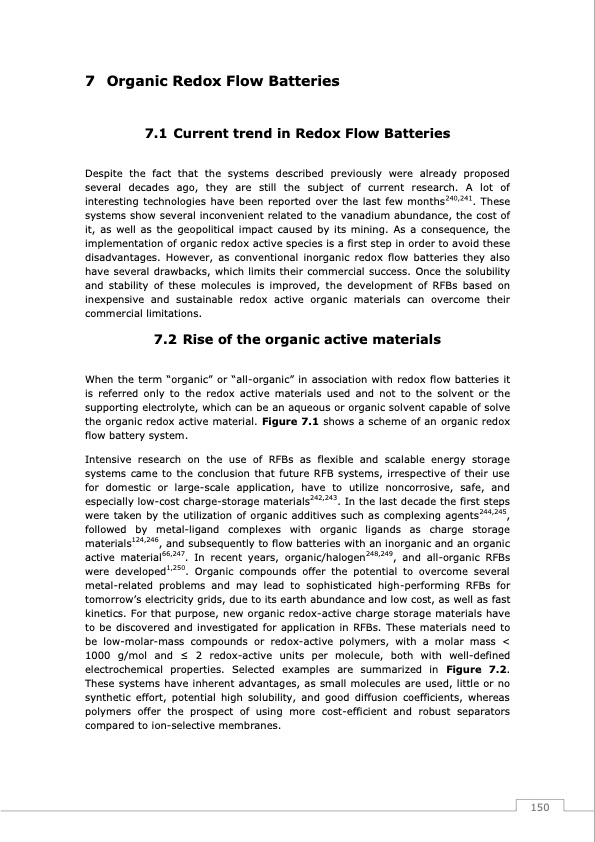
PDF Publication Title:
Text from PDF Page: 151
7 Organic Redox Flow Batteries 7.1 Current trend in Redox Flow Batteries Despite the fact that the systems described previously were already proposed several decades ago, they are still the subject of current research. A lot of interesting technologies have been reported over the last few months240,241. These systems show several inconvenient related to the vanadium abundance, the cost of it, as well as the geopolitical impact caused by its mining. As a consequence, the implementation of organic redox active species is a first step in order to avoid these disadvantages. However, as conventional inorganic redox flow batteries they also have several drawbacks, which limits their commercial success. Once the solubility and stability of these molecules is improved, the development of RFBs based on inexpensive and sustainable redox active organic materials can overcome their commercial limitations. 7.2 Rise of the organic active materials When the term “organic” or “all-organic” in association with redox flow batteries it is referred only to the redox active materials used and not to the solvent or the supporting electrolyte, which can be an aqueous or organic solvent capable of solve the organic redox active material. Figure 7.1 shows a scheme of an organic redox flow battery system. Intensive research on the use of RFBs as flexible and scalable energy storage systems came to the conclusion that future RFB systems, irrespective of their use for domestic or large-scale application, have to utilize noncorrosive, safe, and especially low-cost charge-storage materials242,243. In the last decade the first steps were taken by the utilization of organic additives such as complexing agents244,245, followed by metal-ligand complexes with organic ligands as charge storage materials124,246, and subsequently to flow batteries with an inorganic and an organic active material66,247. In recent years, organic/halogen248,249, and all-organic RFBs were developed1,250. Organic compounds offer the potential to overcome several metal-related problems and may lead to sophisticated high-performing RFBs for tomorrow’s electricity grids, due to its earth abundance and low cost, as well as fast kinetics. For that purpose, new organic redox-active charge storage materials have to be discovered and investigated for application in RFBs. These materials need to be low-molar-mass compounds or redox-active polymers, with a molar mass < 1000 g/mol and ≤ 2 redox-active units per molecule, both with well-defined electrochemical properties. Selected examples are summarized in Figure 7.2. These systems have inherent advantages, as small molecules are used, little or no synthetic effort, potential high solubility, and good diffusion coefficients, whereas polymers offer the prospect of using more cost-efficient and robust separators compared to ion-selective membranes. 150PDF Image | Redox Flow Batteries Vanadium to Earth Quinones

PDF Search Title:
Redox Flow Batteries Vanadium to Earth QuinonesOriginal File Name Searched:
FJVG_TESIS.pdfDIY PDF Search: Google It | Yahoo | Bing
Salgenx Redox Flow Battery Technology: Salt water flow battery technology with low cost and great energy density that can be used for power storage and thermal storage. Let us de-risk your production using our license. Our aqueous flow battery is less cost than Tesla Megapack and available faster. Redox flow battery. No membrane needed like with Vanadium, or Bromine. Salgenx flow battery
| CONTACT TEL: 608-238-6001 Email: greg@salgenx.com | RSS | AMP |